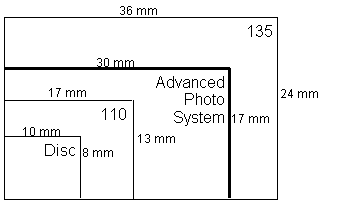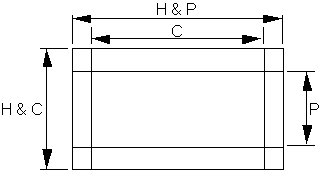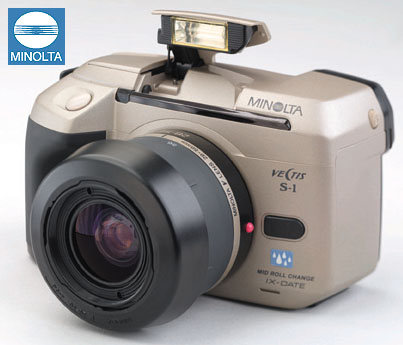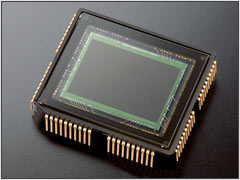Digital Photography from 20,000 Feet
by Wesley Fink on September 25, 2006 12:05 AM EST- Posted in
- Digital Camera
The Digital SLR
Several factors delayed the move to SLR technology for digital photography. First, the early sensors were much lower megapixel resolutions, far too low to begin to compete with film photography. Photo hobbyists saw few advantages to moving to a low resolution system since the reason they used an SLR was high image quality. It wasn't until resolutions reached the 2 to 4 megapixel range that there was any interest in a digital SLR.
Second, the early sensors were very small, developed primarily for video usage. Some tried to develop proprietary systems based on a smaller sensor size with more compact lenses, but nothing caught on in the industry. The cost of early sensors was also astronomical, making the early digital SLR cameras only useful for production, high volume photography where the cost could be justified.
Third, with sensor resolution and size in constant development it was much easier to design a point-and-shoot camera around each new sensor generation. Until sensor size stabilized, a digital SLR that used existing lens systems was not practical.
APS (Advanced Photo System)
35mm first appeared on the scene in the 1930s and the film format simply took 35mm motion picture film and spooled it into a light-tight canister. By the 1960s, with point-and-shoot and developments in SLR technology, 35mm had become king of the film formats. Even as film manufacturers tried to introduce other film formats, 35mm continued to grow and prosper. With the very early developments in digital photography, Kodak, Fuji and others saw the handwriting on the wall for film photography. One of the ongoing complaints about 35mm film, however, has been that the 2:3 image format required image loss in almost every standard print size. 8x10 and 5x7 are neither a 2:3 ratio and both required cropping of the 35mm negative.

In 1996 a new APS (Advanced Photo System) initiative by Kodak, Fujifilm, Minolta, Nikon, Canon and others was introduced to save film by standardizing on new ratios and adding new "computer-like" data storage capabilities in the taking and processing of images. APS included a new film size - 30.2mm x 16.7mm - that could be printed full-frame (H or HDTV format), or use standard crops of 25.1mm x 16.7mm (C or Classic 2:3 format) or 9.5mm x 30.2mm (P or Panorama). Actually, the image size that was always shot was the 30.2mm x 16.7mm, and the other sizes were just standard crops.

The industry was confident they could sell APS, which in the most common C view was only about 55% of the already small 35mm size. Some manufacturers like Minolta developed new APS lens lines with smaller cameras and lenses, and Canon and Nikon developed APS camera bodies that could mount their regular lenses - and a few custom APS lenses.

In the end, APS failed in the film market, but it is important in our discussion of Digital Photography because it was also a standard for digital development. At the time of the APS initiatives, it seemed reasonable to aim for development of digital sensors for that same APS format, so lenses for both systems were interchangeable. The industry aimed for the APS C size sensor, which would be about 16.7mm x 25.1mm the same ratio (2:3) as the classic 35mm format. This allowed existing 35mm lenses to be used, with a lens factor of 1.5 to 1.6, and the development of new lenses with a smaller image circle.
What do we mean by Lens Factor? Why does it matter?
The Lens Factor
APS really doesn't matter in the film market, except as a brief and intense flurry of activity that has produced a huge number of APS cameras in every imaginable format. Some of the high-end models are particularly interesting and will become collectibles. APS cameras like the tiny Minolta Vectis S-1 SLR system, the Canon IX, and Nikon Pronea are remarkably well-built and intelligent designs for the APS format.

The APS may be discontinued and dying in the film market, but it is alive and well in today's Digital SLR market. Today Sony, Nikon, Canon, Pentax, Minolta, Samsung and every other production SLR on the market (except Olympus) uses a sensor that is approximately APS C size. This matters because the lenses designed for 35mm SLR photography do not behave the same when used to capture images with the smaller APS sensor.
Several factors delayed the move to SLR technology for digital photography. First, the early sensors were much lower megapixel resolutions, far too low to begin to compete with film photography. Photo hobbyists saw few advantages to moving to a low resolution system since the reason they used an SLR was high image quality. It wasn't until resolutions reached the 2 to 4 megapixel range that there was any interest in a digital SLR.
Second, the early sensors were very small, developed primarily for video usage. Some tried to develop proprietary systems based on a smaller sensor size with more compact lenses, but nothing caught on in the industry. The cost of early sensors was also astronomical, making the early digital SLR cameras only useful for production, high volume photography where the cost could be justified.
Third, with sensor resolution and size in constant development it was much easier to design a point-and-shoot camera around each new sensor generation. Until sensor size stabilized, a digital SLR that used existing lens systems was not practical.
APS (Advanced Photo System)
35mm first appeared on the scene in the 1930s and the film format simply took 35mm motion picture film and spooled it into a light-tight canister. By the 1960s, with point-and-shoot and developments in SLR technology, 35mm had become king of the film formats. Even as film manufacturers tried to introduce other film formats, 35mm continued to grow and prosper. With the very early developments in digital photography, Kodak, Fuji and others saw the handwriting on the wall for film photography. One of the ongoing complaints about 35mm film, however, has been that the 2:3 image format required image loss in almost every standard print size. 8x10 and 5x7 are neither a 2:3 ratio and both required cropping of the 35mm negative.

In 1996 a new APS (Advanced Photo System) initiative by Kodak, Fujifilm, Minolta, Nikon, Canon and others was introduced to save film by standardizing on new ratios and adding new "computer-like" data storage capabilities in the taking and processing of images. APS included a new film size - 30.2mm x 16.7mm - that could be printed full-frame (H or HDTV format), or use standard crops of 25.1mm x 16.7mm (C or Classic 2:3 format) or 9.5mm x 30.2mm (P or Panorama). Actually, the image size that was always shot was the 30.2mm x 16.7mm, and the other sizes were just standard crops.

The industry was confident they could sell APS, which in the most common C view was only about 55% of the already small 35mm size. Some manufacturers like Minolta developed new APS lens lines with smaller cameras and lenses, and Canon and Nikon developed APS camera bodies that could mount their regular lenses - and a few custom APS lenses.

In the end, APS failed in the film market, but it is important in our discussion of Digital Photography because it was also a standard for digital development. At the time of the APS initiatives, it seemed reasonable to aim for development of digital sensors for that same APS format, so lenses for both systems were interchangeable. The industry aimed for the APS C size sensor, which would be about 16.7mm x 25.1mm the same ratio (2:3) as the classic 35mm format. This allowed existing 35mm lenses to be used, with a lens factor of 1.5 to 1.6, and the development of new lenses with a smaller image circle.
What do we mean by Lens Factor? Why does it matter?
The Lens Factor
APS really doesn't matter in the film market, except as a brief and intense flurry of activity that has produced a huge number of APS cameras in every imaginable format. Some of the high-end models are particularly interesting and will become collectibles. APS cameras like the tiny Minolta Vectis S-1 SLR system, the Canon IX, and Nikon Pronea are remarkably well-built and intelligent designs for the APS format.

The APS may be discontinued and dying in the film market, but it is alive and well in today's Digital SLR market. Today Sony, Nikon, Canon, Pentax, Minolta, Samsung and every other production SLR on the market (except Olympus) uses a sensor that is approximately APS C size. This matters because the lenses designed for 35mm SLR photography do not behave the same when used to capture images with the smaller APS sensor.










81 Comments
View All Comments
silver - Monday, September 25, 2006 - link
I think this is one tidbit that you might write on when you're realy bored. My images are backed up using Verbatim UltraLife Gold DVD-R media. You also need to make sure that they stay cool and dry much as you do with film. They're not as sensitive to humidity but as certainly far more sensitive to heat.Googer - Monday, September 25, 2006 - link
Panasonic is makeing and selling cameras based on good old Leca Lens. If you have a leica lens from any point in the last 55+ years, it will be compatable with a Panasonic/Leica Camera.
Wesley Fink - Monday, September 25, 2006 - link
The Pansonic Lumix DMC-L1 digital SLR uses a Leica lens built with a four thirds mount. This is the new digital only mount pioneered by Olympus. The LMC-L1 is mentioned in the guide.silver - Monday, September 25, 2006 - link
One of my friends has one of these and the images are simply incredible. He states that the Opticla Image Stabilization is simply the best he could find.wilburpan - Monday, September 25, 2006 - link
As someone used to shooting with film cameras, I can say that I still notice some shutter lag when using digital SLRs, even with current models. To write this off as "Virtually none of the lags of early digital cameras remain" is to ignore a real factor when it comes to the use of any camera.To put this another way, if a digital camera website stated that the choice of CPUs was unimportant in buying a computer because all modern day CPUs were fast and powerful enough, the readers of this site probably would bust a gut.
There are also speed issues involved with other uses of a digital camera that need to be addressed. The Nikon D80 takes about 1.4 seconds to store and then display an image after the shutter has been pressed. The speed of this process varies widely from camera to camera. Similar variances in speed and performance come into play when performing tasks such as playback of pictures taken, the time that it takes to process bursts of photos when shooting in continuous mode, etc.
silver - Wednesday, September 27, 2006 - link
Regarding shutter lag, digital cameras will always be slower than film. There's no way around that. My FM2n's have near instantaneous shutter release and are quite the opposite of my admittedly dated Fuji S602. What manufacturers need to do is to have separate power sources (batteries) for lens focusing and camera functions other than CCD/CMOS/memory charging. Obviously this would complicate the camera so they probably aren't considering this option.Wesley Fink - Monday, September 25, 2006 - link
This is where we start to get into questions about what test is real. The file flush time on a Nikon D80 is 2.0 seconds for a fine jpeg and a little less than 3s for a RAW+jpeg. However, you never encounter this becuase of the memory buffering built into the Nikon D80 and every other digital SLR camera. The D80 can do 3 fps for a little over 30 seconds shooting raw+jpeg, and with fine jpeg it can shoot 3fpm until you run out of flash card room or battery.I consider the D80 time of 160ms viewfinder blackout (0.16s), and a less than 0.1s from off to shot negligible for almost any users. Even the Sony, which has a 1 second start-up, is using almost all that time to clean the sensor before shooting, while shot-to-shot is very competitive with the best SLRs around. Some users might be happier if you could turn off the cleaning on start. While this may be very important for some users, it is doubtful that the small differences in recent digital SLR cameras will really be noticable or matter to most users.
dpreview is an excellent and respected digital review site, and I have sent many readers there with their questions. They often come back with more questions than answers, which usually means they found the technical level too far above their skills and needs. We can't be all things in Digital Camera reviews so we will likely err toward the more basic side.
We'll consider your suggestion about start-up times, but I'm not convinced yet.
yacoub - Monday, September 25, 2006 - link
I appreciate your article but I don't know: I think that folks into digital photography, no matter what other hobbies they have, including computer hardware or gaming, are knowledgable enough (or are competent enough to gain the knowledge needed) to make good use of a site like DPReview, which offers about all the info most need to make an intelligent purchase of a digital camera. Plus that being their primary focus (and has been for years), they automatically get much more credibility than a computer hardware site can hope to achieve by writing content basically saying "look we can do this too!" and writing what most good highschool photography classes are teaching today anyway.I guess my question is, why not stay focused on computer component hardware? All branching out does is reduce the chance of the main hardware getting the attention it needs. There are umpteen motherboard, videocard, and RAM reviews and guides yet to be completed or even begun, yet you're going off into digital photography land? That's kind of disappointing. For that hobby there are already many strong resources for folks who are into that, and many more for folks who want a simple pocket-sized point-n-shoot (which is the majority of folks). Why not focus on being the strong resource in computer hardware that folks in this hobby need?
fanbanlo - Monday, September 25, 2006 - link
Maybe AnandTech can explain to use what are the new technology built into the sensor rather than meaningless marketing terms givin to them.Different algorithm used? what's their computational power?
Why shoot RAW? RAW-enabled software review!?
Thx
Heidfirst - Monday, September 25, 2006 - link
For the lower end DSLRs (D50,350D,K100D etc.) I think that you should also review the standard kit lens as the majority of buyers will probably be buying it with the body as a package.By the time that you start hitting EOS30D type level imo most people will probably have lenses already or be buying a better lens than the entry level kit lens. Also if they are paying that for a body they quite probably are reasonably knowledgeable photo enthusiasts & maybe Anandtech isn't going to be the first place that they look for reviews so sticking to the lower end at least initially sounds reasonable to me.
The idea of a standard test scene is interesting but it would have to be reproducible which means in the studio & that means that it's less representative of the conditions in which most people will use them (I imagine that the % of even current DSLR users who shoot in the studio is in single figures & probably low single figures at that).